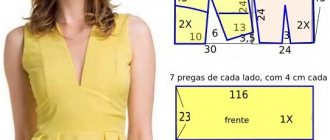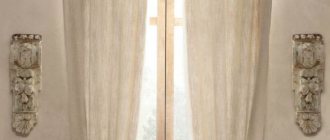Greek style dresses have been very popular every summer for several years in a row. This demand is explained by the simplicity and unique elegance of these outfits: they are equally good for an evening event and for a walk along the embankment. Greek dresses can also act as wedding dresses, and they are suitable for girls with any figure, and even look good on expectant mothers.
The patterns and recommendations offered in this article will help you sew a Greek dress for any occasion, depending on the fabric and style you choose, it can serve as an outfit for work, a date, or clothes for relaxing on the seashore.
Pattern of a dress in the Greek style to the floor
A floor-length dress makes every girl feminine, elegant, sophisticated, emphasizes her advantages, and hides minor figure flaws.
But they have one drawback - they are very expensive in boutiques. Is it possible to sew a long dress yourself, at home? Of course you can! The easiest way to sew a floor-length Greek dress is that women who have absolutely no experience in sewing and needlework can cope with this task. This option is ideal for summer walks, parties, and visiting. If you still don’t dare to sew a dress yourself, take a look at https://iltanishop.ru, where you can find a collection of women’s clothing for every taste and budget.
Selecting fabric
To create elegant folds on a Greek dress, you need to carefully choose the right fabric. Usually, for evening wear, thin silk and chiffon are used.
For a summer dress, crepe de Chine, cambric, and gauze are good options. Viscose staples and natural silk also drape softly. The loose style of the dress will save you from the heat and hide figure flaws.
Necessary materials and tools for sewing a Greek dress
You can design a Greek dress yourself very quickly, having a piece of fabric 3-3.5 meters long and 1.5 meters wide - regardless of your figure, because the dress must have drapery. A summer dress should be light and elegant. In order for it to turn out exactly like this, it is worth buying flowing and easily draped fabrics. For example, natural or artificial silk, fine knitwear, muslin.
Also for sewing you will need:
- sewing machine, overlocker (you can only get by with a machine);
- sewing meter, scissors, chalk or soap;
- ribbons, braid, additional accessories.
Scissors must be used very sharp, threads must be matched to the fabric, sewing machine needles - number 75, additional accessories depending on desires and fabric. You will also need pins and decorative cords for drapery.
What materials are used in tailoring?
Delicate flowing fabrics are a priority. These are satin, chiffon, organza, silk and all similar luxurious materials. It is important that the drapery looks luxurious, so cotton, gabardine and various casual fabrics would be inappropriate here. Belts based on the bodice with the same fabric on top as the dress are used as decoration. The images are complemented with artificial precious stones, rhinestones, and small sparkles. Casual chiffon models are not decorated with anything, but are complemented by beautiful expensive shoes and accessories.
Measurements, fabric calculations, pattern making
To properly tailor a Greek dress, you do not need to have any special skills or be a designer. The product can be modeled on the figure. Therefore, a paper pattern is practically not needed, because this type of dress does not involve any difficult moments when sewing, there is no need to make darts and other complex elements. Simply put, the Greek dress pattern is a regular rectangle.
First you need to measure the length of the dress from the seventh cervical vertebra to the floor and multiply the measurement by two. Take a corresponding piece of fabric, mark the middle, and carefully make a small cutout for the head in the center. After this, you need to put the fabric on yourself and start modeling the dress. While working, you need to carefully secure the desired shape using regular pins or taking a thread and a needle. We need to adjust the neckline (deeper in the front and/or back), determine the length of the armhole, and baste or mark the side seams.
Cut out the linings
Open the shelves and backs
Using the pattern base, cut out the lining of the dress. When cutting the lining, allowances for a loose fit are taken into account; they should not be too large, it depends on the stretchability of the lining fabric. Increases are made to the waist, chest and hips. Toward the bottom, the lining expands along the side lines. A chest dart is designed on the shelf. The width of the allowances on the lining corresponds to the width of the allowances on the dress.
Then the lines are transferred to symmetrical sides. Darts and side seams are processed.
The side seams are pressed. In the area where the zipper is sewn in, the seam is not sewn down, the sections are overcast and ironed.
Connection of bodice with skirt
Baste and then stitch the bodice with the skirt using a double stitch, overcast the cut on the overlocker from the side of the bodice. Remove the basting threads, including the second line for gathering. Lightly press the seam allowance onto the skirt.
Lining setup
The lining is folded in the centers, the side seams are aligned and pinned. Align all cuts and secure with pins. The bodice of the dress is placed on top of the lining and changes are made along the armholes and neckline.
How to sew a simple floor-length Greek dress yourself
Sewing the dress will take place in several stages, all of them are very simple, but accuracy during work will not hurt.
While working on the product you will need to perform the following actions:
- Thread the necessary threads into the sewing machine;
- Make sure that the edges of the fabric for stitching are smooth and neat;
- Connect the side sections of the dress, leaving a cutout for the arms (the so-called armholes);
- Finish the bottom of the dress: if the fabric is fraying a lot - with a hem seam with a closed cut, in other cases - with a hem seam with an open cut, which is pre-sewn on an overlocker;
- Finish the neckline and armholes of the dress with bias tape or decorative ribbon.
Attaching a hidden zipper
Place the hidden zipper with its teeth towards the side seam line, baste and stitch, first one side then the other. For ease of sewing in the zipper, spread out the lower part of the armhole.
Read more in the master class: how to sew a hidden zipper into an evening dress
Match the zipper allowances with the lining allowances along the side seam on the wrong side.
Securing the bottom of the armhole with machine stitching.
Iron the fastener section.
Along both armholes, place finishing stitches 0.1 cm from the edge.
Dress decor in Greek style
The last stage of work is adding decorative elements. Using decorative tape, braid or cord, you can carefully gather the fabric on the shoulders, making them open, add folds, make them larger or smaller.
If there is some fabric left, you can sew a thin belt from it, tie it under the chest and decorate it with a beautiful flower. Then a long floor-length dress in the Greek style will look simply excellent.
Accessories and shoes
Gold jewelry will be a beautiful addition to the Greek look. And on your feet you can wear light-colored sandals with ankle support, for example, gladiator heels, or classic shoes. But it’s better to get rid of the rings and buy several thin bracelets, and preferably wear several of them on your hand. A small, neat clutch bag will be an excellent finishing touch to your outfit.
The main thing is to follow the color scheme, for example, everything is gold or silver. Mixed bright colors of jewelry will look completely out of place..
Greek style dress styles
There are a lot of options for beautiful clothes today. It just makes my eyes wide open! And many models are available for making with your own hands, as long as you have a successful dress pattern in the Greek style at hand. Burda is a wonderful magazine. It provides readers with not only a variety of styles of outfits, but also beautifully designed patterns for cutting.
Although in many cases, some kind of exclusive dress pattern in the Greek style is not required at all. Often, an outfit is made by draping a piece of fabric over the figure and securing the garment with pretty brooches, artificial flowers, pins, or a few stitches.
Other styles are based on conventional models using embroidery on the chest, along the bottom of the dress, and on the sleeve cuffs, made in the Greek style.
Material
Preference is given to light, flowy fabrics such as chiffon, silk, satin and the like. And all because of the drapery, which is present on almost all models. This preference can also be explained by the origin of the style. After all, in Greece it is always warm, which means clothes were worn appropriate to the weather conditions. An excellent solution for choosing decorations would be small precious stones, shiny sequins and belts made from natural materials.
In everyday models, decor is most often absent, but this does not spoil these beautiful summer dresses.
Dress created using drapery
You can make such an outfit in just a few minutes. Not only that, to sew such a dress in the Greek style with your own hands, you don’t need a pattern as such.
To work, take a piece of fabric across. The middle is held near one side. Both ends lead to the shoulder opposite the draped side. You can pin the fabric directly on the shoulder, or you can sew a narrow strap in the right place.
Now, with a needle with a thread inserted into it, the fabric is grabbed on the side so that it does not fall apart. It is recommended to make small, beautiful folds during baiting. The seam is made from the middle of the thigh to the armpit. After this preparatory work, the area caught on the live thread can be sewn on a machine.
It is worth understanding that the seam will be obvious, so you should carefully select the color of the threads. In some cases, you can limit yourself to hand stitching. Again, neatness and evenness of the stitching will play a huge role here.
As you can see, to make a luxurious outfit, sometimes you don’t need a complex pattern at all. Floor-length Greek-style dresses can be made in a few minutes, if you have a well-draped material on hand.
Greek dress without seams
Some people may not believe that you can sew a luxurious outfit without threads and needles. And the dress pattern itself in the Greek style will be made with minimal effort. That is, a piece of fabric is simply cut off from a roll!
Of course, there are some things you'll have to take care of. These are accessories for clothing, such as brooches for pinning shoulder joints and a wide belt.
So, let's start creating a masterpiece!
- A well-draped, ironed fabric is laid out on the floor or large table so that the direction of the grain thread goes transversely.
- The side cut lines are folded towards the middle of the rectangle.
- The upper folded corners are moved slightly apart to form a neckline.
- These places are fixed with hairpins (brooches) or thread.
- Now the dress is put on the figure with the open part forward. The fabric is beautifully laid out in folds and a belt is put on that will hold them in the desired condition.
If you wrap the robe a little, you will get a rather modest model of a Greek dress. And if part of the body is left open between the fabric, and the belt is fastened almost at the waist, then the model will be extremely extravagant. This style is suitable for ladies with an ideal figure and high breasts.
Who to wear
The gentle spirit of ancient Greece in clothing suits absolutely every woman at any age. It doesn’t matter what shape or size you have, fashionistas can always use it to hide imperfections and highlight what they need.
So, for example, overweight girls will be able to hide extra pounds, and too thin girls, on the contrary, will be able to add volume to their hips, thanks to the multi-layered fabrics. Pregnant women really love this type of clothing, and all because of the high waist, which does not pinch the tummy and even hides it in the early stages, but in later stages, on the contrary, organically emphasizes it. Nowadays, brides very often choose a Greek theme for their weddings. And thanks to the femininity and romance of the style and new variations, designers create amazing wedding images that will captivate all guests.
Greek dress with front seam
You can design an outfit in a similar way by stitching the connection of the side panels folded to the middle of the segment. In this case, you also do not need a specially designed pattern for your figure. Dresses in the Greek style have such a wonderful feature: the fabric and the ability to beautifully distribute the folds of the drapery are important.
The instructions for making the dress are quite simple.
- The fabric is folded in half crosswise face to face.
- The seam is not completely stitched. You need to leave a gap equal to the depth of the cutout. By the way, the dress can be worn either with a slit in the front or in the back.
- The resulting “sleeve” is laid out on the table so that the seam runs exactly in the middle of the product, with the embroidered edges facing up.
- Pull the edges of the cut apart slightly so that a neckline is formed.
- The corners of the free ends are fastened to the edge of the material located underneath. You can stitch the edges a little, then the dress will have hangers. And if you fasten it pointwise (with a thread or a brooch), then the shoulders will be open.
- Having treated the neckline so that it does not get wet, you can put on the dress, beautifully laying out the folds and tying the belt.
Round neck dress
This summer outfit is perfect for both young slender girls and ladies with luxurious shapes. You will need a fairly simple pattern for sewing. Greek style dresses for plus size people fit well if the belt is located slightly below the waist. The side seams can be machine stitched, and the neckline and armholes can be finished with bias tape. In some cases, there is a reason to process the armholes with a simple hem of the cut.
Making such patterns for summer dresses in the Greek style on your own will not be difficult even for a novice seamstress. The length of the outfit can be any: a short tunic looks just as interesting as a long evening robe.
Hairstyle
Festive voluminous hairstyles will be the ideal solution to complete this outfit. Headbands, tiaras and combs look very advantageous as an addition. Many makeup artists also weave fresh flowers into their hair when creating a Greek look. It is important that the hairstyle matches the outfit and the spirit of the era from which it came.
Straight hair and sloppy strands are definitely not suitable as a hairstyle.
Long evening dress in Greek style
For ladies with a luxurious figure, we can recommend a dress with a “bag”, gathered at the top with a drawstring. Thin straps can be placed on the shoulders from front to back. Sometimes the dressmaker passes one strap through the back along the neck and fastens its ends in front. A sort of clamp is formed. To make such a dress in the Greek style with your own hands, you will need a very simple pattern, in the form of a rectangle, where the width of the segment will be the length of the robe, and its length will be the girth of the figure.
So you shouldn’t feel complex about your weak sewing and cutting skills. You need to bravely pick up scissors and a needle and start creating a masterpiece that will allow you to become unique, beautiful and attractive.
Everyday
A sundress in the Greek spirit has long won the hearts of many ladies around the world. You don’t often find such a comfortable and beautiful outfit on store shelves. A simple cut, pleasant natural fabric - all this will give you confidence in everyday life. You can add a thin rope strap to this look. Again, you shouldn’t burden yourself with a lot of jewelry and accessories; the dress itself adorns you perfectly. By the way, this particular look can be complemented with a simple, uncomplicated hairstyle that is most convenient for you.
How to sew a dress in the Greek style with and without a pattern
Greek style dresses have been very popular every summer for several years in a row. This demand is explained by the simplicity and unique elegance of these outfits: they are equally good for an evening event and for a walk along the embankment. Greek dresses can also act as wedding dresses, and they are suitable for girls with any figure, and even look good on expectant mothers.
The patterns and recommendations offered in this article will help you sew a Greek dress for any occasion, depending on the fabric and style you choose, it can serve as an outfit for work, a date, or clothes for relaxing on the seashore.
Pregnant
Women want to look good in any situation. Therefore, this slightly fitted option is simply ideal for pregnant women. A high waist will not pinch your tummy and cause discomfort. And this is very important for pregnant women! Choose subtle, lightweight summer accessories to accentuate thin wrists and tie your hair up with ribbons to complete the look. Silver, by the way, looks better on pregnant women than on anyone else, so feel free to wear silver earrings.
So, what can we say about this type of model? One thing is immediately clear - this is universal clothing for any occasion, which means you must definitely purchase this item of clothing in the appropriate stores. It’s quite easy to do this, because they offer a huge range. Secondly, this dress does not force you to further decorate the image, because it itself perfectly emphasizes all the feminine beauty. For inspiration to create outfits for the goddesses of Olympus, a small selection of photos will be presented below.
Greek dress patterns from Marlene Mukai
Using the drawings published below, you can sew a dress in sizes from 36 to 56, a size chart is attached.
What you need
To work, you will need a piece of chiffon or cambric measuring approximately 3.6/1.4 m; you can use 2.3/1.5 m knitted tulle as a lining; you may also need interlining and decorative elements for the belt and collar.
You can also use any lightweight fabric for dresses that can drape easily.
Greek dress with American armhole
Draw a pattern of the desired size on paper, following the drawings. Cut out the details and transfer to fabric.
Greek dress patterns from Marlene Mukai
Basics of proper combination
If, for example, you like the color ivory, then you can choose for yourself the image of a modern Aphrodite, as in this photo.
The asymmetry inherent to the Greek Goddess of Love can be created in any number of ways, such as with elaborate decorative trim on one shoulder strap, as here.
Or you can simply make a flowing drape on one shoulder, combined with a wide belt at a high waist. In this case, it is advisable to decorate the belt with special luxury; you will get a delightful outfit for the bride, as in this photo.
If you combine ivory dresses with pearl or gold necklaces, bracelets, brooches, then the image of a Greek woman will immediately appear before you.
Modern designers love to diversify antique dresses with different lengths, flounces, contrasting colors, and decor with sequins, beads, and chains. The main thing is feminine dresses, incredibly beautiful and romantic.
- In this video you can see how to quickly sew a summer bright Greek dress.
- There are many different models in this video based on the style in question.
The art of beautiful wrapping
It’s interesting, but this particular style makes it possible to create a dress from a piece of fabric directly on yourself or on the customer of a Greek dress, as almost all fashion designers work.
Because the classic Greek dress, or chiton, is a rectangular piece of fabric that ancient Greek women wrapped from left to right around the body and secured on the shoulders with two buckles - brooches, decorated with rhythmic Greek patterns.
Here are the types of dresses you can make without the hassle of constructing a pattern from a suitable piece of flowing fabric.
You can mark your dress as belonging to the Greek style if you decorate a wide belt at the waist or on the line above the waist with traditional Greek ornaments. For example, “palmettes” - stylized drawings of palm crowns.
- Also “meanders”, “ionics” and others.
- The video below shows an interesting option on how to wear a beach dress in the Greek style.
Selecting fabric
To create elegant folds on a Greek dress, you need to carefully choose the right fabric. Usually, for evening wear, thin silk and chiffon are used.
For a summer dress, crepe de Chine, cambric, and gauze are good options. Viscose staples and natural silk also drape softly. The loose style of the dress will save you from the heat and hide figure flaws.
Several ways to create
There are times when you urgently need an evening dress in an interesting style, Greek, for example, but there is no suitable outfit in your favorite store. Don’t waste time searching, it’s better to master any of the methods suggested below, it will always come in handy in life! In some cases, you don’t even need a pattern, you just need to have basic sewing skills.
Scarf dress
The easiest way to create a Greek summer dress is to use fabrics with processed sections of suitable colors. Take 4 scarves and tie them together as in the picture.
- We fasten the knots on the shoulders, decorate with a brooch, and tie a wicker belt around the waist.
- Two large scarves can be fastened in places as suggested in the following sketch.
- Here are the options for dresses made from scarves or coupon fabric:
Airy summer outfit
- If you like a light fabric, such as chiffon, then without delay, you need to buy it and sew yourself a flowing floor-length dress, in which, like a Greek goddess, you can walk both along the seashore and along the city streets.
- And you can also sew a red dress like the one in the photo above quite quickly and easily.
To work, you will need a piece of fabric 2 times your height and 140 cm wide.
Here is a diagram of such a dress:
The manufacturing work is as follows: fold the fabric in half, cut out the neck to the depth we need. To achieve drapery, we gather the shoulders and decorate the dress with golden ribbons and straps. Or you can sew a Greek dress using this simple pattern:
Read this: Upcycling Old Clothes: Upgrade Tips
Evening Dress
- The next way to create a Greek dress is more complicated; you need to try a little and cut it out, adhering to the following pattern.
- These should make such gorgeous party dresses.
For the top, chiffon or cambric is perfect, about 3.5 m by 1.4, and for the lining you can take knitted tulle 2.3 m by 1.5 m.
In accordance with your dimensions, you need to create a pattern on paper and transfer it to the fabric.
- Here is another version of an antique evening dress.
- Choose any metallic stretch fabric and use the pattern below to get to work!
- This video contains instructions for sewing an evening dress made of velvet with drapery.
- How many options can you come up with for a Greek dress from one piece of black fabric, as in the video below.
- In conclusion, I would like to note that in your wardrobe you should definitely have not just one, but several different styles of dresses for different occasions, in order to be able to be supported by the spirit of the ancient goddesses and win the hearts of your beloved men!
Video on the topic of the article
- These videos have a lot of interesting things about Greek dresses:
Source: https://knittochka.ru/shityo/plate-v-grecheskom-stile-svoimi-rukami.html
Pattern of a short Greek dress
This version of the dress can even be suitable for work; it will be enough to just cover your shoulders with a light blazer. You need to model the dress using the basic pattern of a sheath dress, which you can download in this article.
Short dress in Greek style
How to cut and sew a Greek dress
- Transfer the front of the dress onto paper and draw red lines.
- Next, cut the top part from the front part of the dress, passing along the waist, and also make cuts along the red lines. Now spread it apart.
- The remaining lower half is the skirt, cut along the darts and spread apart for pleats. Fig 1.
- Re-shoot the back and model it as in drawing 2.
- You don’t have to sew in a zipper, since the fabric for such a dress should have good stretch.
- Cut the straps separately with a width of 8 cm, fold them in half and sew them, in the end the width should be about 4 cm. Adjust the length during fitting, the orientation should be 16-18 cm.
Preparing the dress for the first fitting
Laying out the assembly
To prepare the details of the dress for fitting, you need to assemble the ruffle along the shoulder seams, the bottom of the bodice and the top of the skirt. To do this, lay two parallel machine lines: the first at a distance of 1.0 cm from the cut, the second at the width of the presser foot from the first line. To get an even gather, you need to pull both threads and tighten the fabric to the desired size.
At the shoulder seams, the size of the gather is equal to the width of the finished shoulder.
Along the bottom of the bodice and the top of the skirt - waist circumference. In this case, the gathering on the bodice and skirt should be distributed in the central part of the parts. To ensure that the parts of the shelf and back do not diverge, they need to be secured with hand stitches along the bottom, taking into account the allowance for the wrap.
Noting the details of the dress
Next you need to baste the shoulder seams, side seams and the seam on the skirt.
Then connect the bodice and skirt together. To do this, insert the bodice into the skirt with the right sides facing inward and sweep it away.
When connecting, the seam on the skirt should be located on the left side, where the zipper will be sewn. For ease of putting on the dress during fitting and for fastening, you need to leave part of the side seam from the armhole uncreased.











